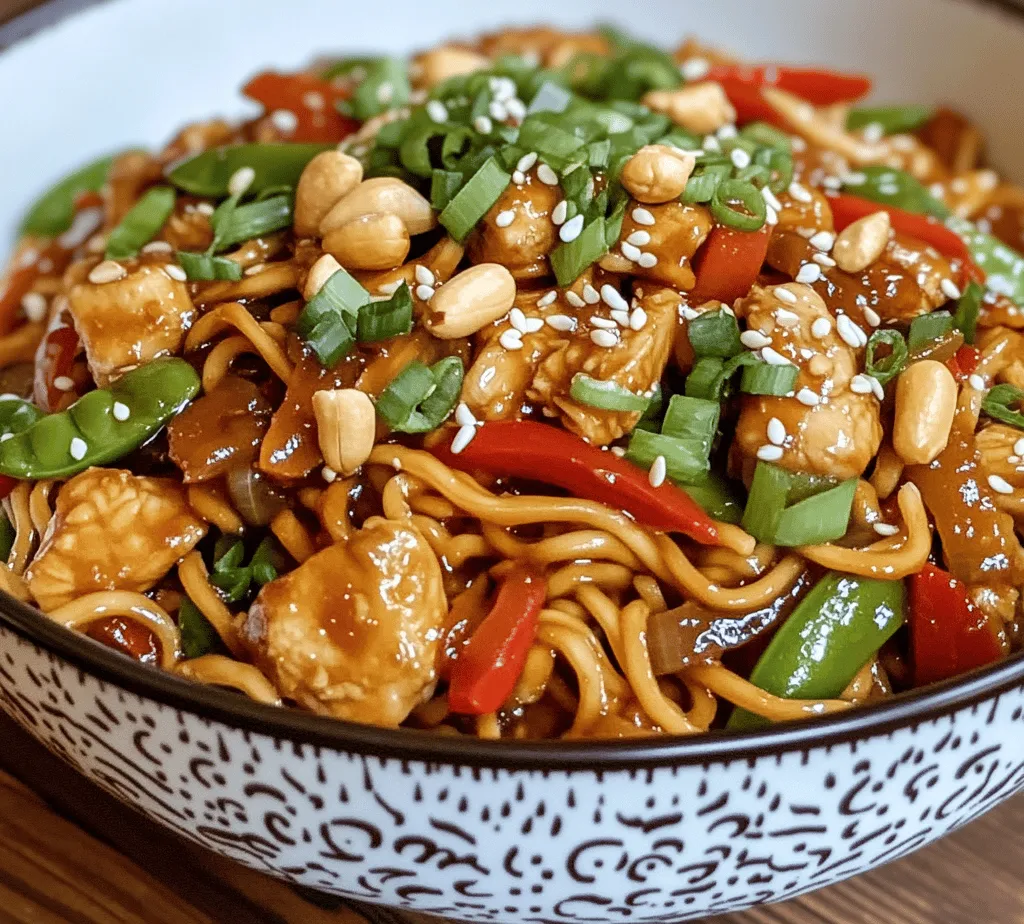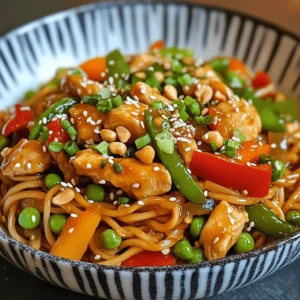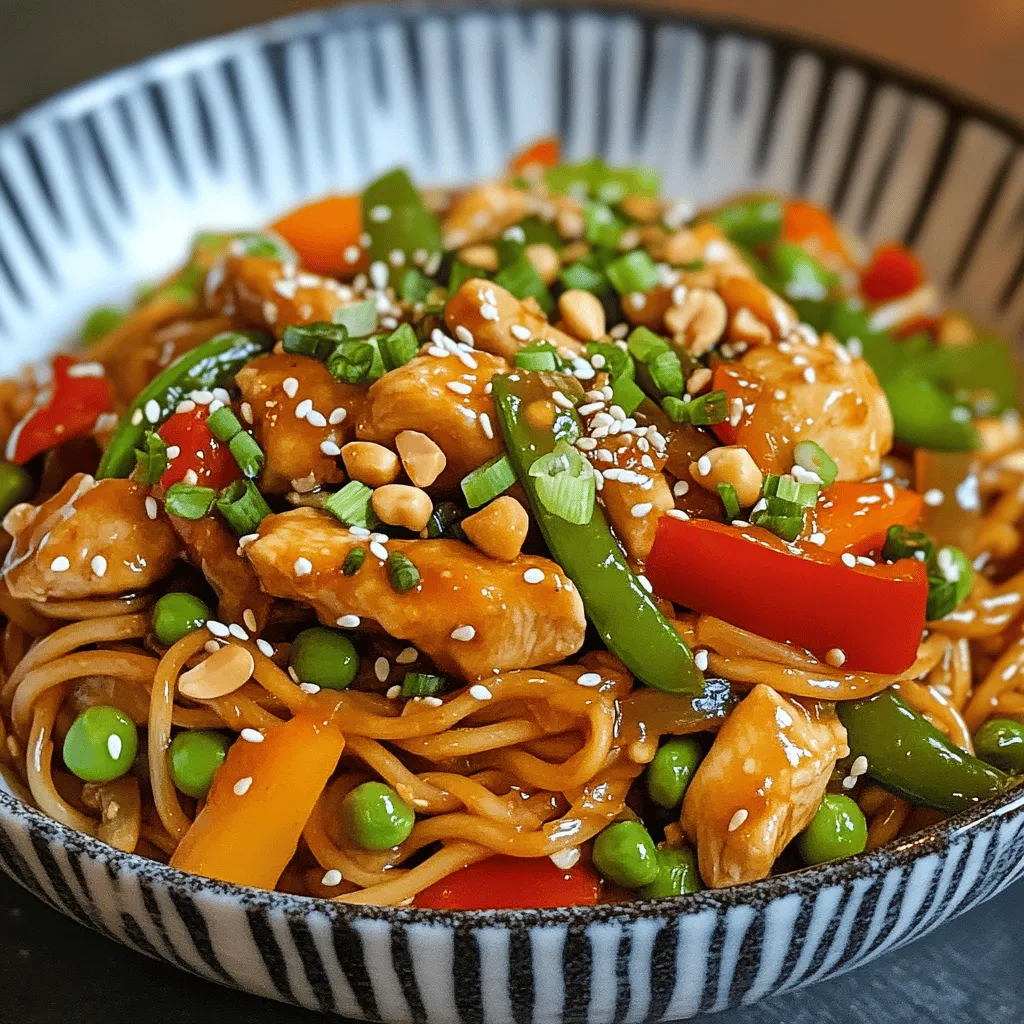Introduction
Kung Pao Chicken is a celebrated dish that has earned its place as a staple in Chinese cuisine, known for its bold flavors and delightful texture. Originating from the Sichuan province, this dish combines tender chicken, crunchy peanuts, and vibrant vegetables, all tossed in a rich, spicy sauce. The traditional preparation often features a balance of heat from Sichuan peppercorns, sweetness from sugar, and umami from soy sauce, creating a taste that is both complex and satisfying.
In recent years, a fusion twist has emerged in the culinary world: Kung Pao Chicken Noodles. This innovative take incorporates the beloved elements of Kung Pao Chicken while introducing egg noodles to create a heartier, more filling meal. The result is a delightful combination of savory chicken and vegetables, enveloped in chewy noodles that soak up the signature sauce, making each bite an explosion of flavor.
In today’s fast-paced world, the importance of balancing taste and nutrition in home-cooked meals cannot be overstated. Kung Pao Chicken Noodles not only deliver on flavor but also provide a well-rounded meal filled with protein, vitamins, and healthy fats. As you embark on this culinary journey, this article will guide you through the intricacies of preparing this dish, from understanding its cultural significance to mastering the cooking techniques that ensure success in your kitchen.
What to Expect
In this article, you can expect a detailed recipe for Kung Pao Chicken Noodles, complete with a breakdown of essential ingredients and their roles in achieving that signature flavor profile. We will cover the nutritional benefits of each ingredient, ensuring that you can enjoy this dish with both taste and health in mind. Additionally, you will find step-by-step instructions for preparing the dish, along with tips for cooking the noodles to perfection. Whether you are a seasoned chef or a home cook looking to expand your culinary repertoire, this guide will set you up for success.
Understanding Kung Pao Chicken Noodles
To truly appreciate Kung Pao Chicken Noodles, it’s essential to delve into its origins and cultural significance. The dish is named after Ding Baozhen, a 19th-century governor of Sichuan, whose title was “Kung Pao.” Traditionally, the dish was prepared with diced chicken, peanuts, and vegetables, and it was often enjoyed by the upper class in Sichuan. Over time, the recipe has evolved and traveled beyond China, finding its way onto menus around the world while being adapted to suit local tastes.
The fusion of Kung Pao Chicken with noodles represents a culinary evolution that embraces the versatility of ingredients. Noodles serve as a comforting base, enhancing the dish’s heartiness and making it a complete meal. The combination of stir-fried chicken and vegetables over noodles not only elevates the dining experience but also allows for a delightful mix of textures: the crunch of peanuts, the tenderness of chicken, and the chewiness of noodles.
Flavor Profile and Ingredient Roles
At the heart of Kung Pao Chicken Noodles is its intricate flavor profile, which is achieved through a careful selection of ingredients. Here’s a closer look at the components that contribute to its signature taste:
1. Chicken Breast: The star protein of the dish, chicken breast is lean and packed with nutrients. It absorbs the flavors of the sauce beautifully, providing a satisfying bite that complements the other ingredients.
2. Egg Noodles: These noodles come in various forms, from thin to thick, and are typically made with wheat flour and eggs. They offer a rich flavor that pairs well with the savory components of the dish. Their ability to hold onto sauces makes them a perfect vehicle for the Kung Pao sauce.
3. Fresh Vegetables: Bell peppers, carrots, and scallions add vibrant color and essential nutrients. Fresh vegetables not only enhance the visual appeal of the dish but also contribute crucial vitamins and fiber, promoting a balanced meal.
4. Peanuts: A nod to the traditional recipe, peanuts provide a delightful crunch and a source of healthy fats. They also add depth to the flavor, complementing the spicy and savory notes.
5. Sauces and Seasonings: The magic of Kung Pao Chicken Noodles lies in its sauces. Soy sauce, rice vinegar, and chili paste work together to create a harmonious blend of umami, acidity, and heat. These ingredients are vital for achieving the authentic taste that defines this dish.
Nutritional Benefits
Kung Pao Chicken Noodles is not only delicious but also nutritious. The dish is loaded with protein from the chicken and peanuts, making it a great option for those looking to maintain or build muscle. The addition of colorful vegetables ensures that you are getting a variety of vitamins, minerals, and antioxidants, all of which support overall health.
The healthy fats found in peanuts contribute to heart health, while the carbohydrates from the noodles provide energy. Additionally, this dish can be easily modified to suit different dietary preferences – you can substitute chicken for tofu or add more vegetables to enhance its nutritional profile further.
Essential Ingredients for Kung Pao Chicken Noodles
Now that we’ve established the cultural significance and nutritional benefits of Kung Pao Chicken Noodles, let’s break down the essential ingredients you’ll need to create this delectable dish. Each ingredient plays a crucial role in achieving the desired flavor and texture.
Chicken Breast
Chicken breast is the primary protein source in this dish. It is low in fat and high in protein, making it an excellent choice for a healthy meal. When selecting chicken, look for fresh, high-quality breast meat that is free from additives. You can also opt for organic or free-range chicken for better flavor and ethical considerations.
Egg Noodles
Egg noodles come in various shapes and sizes, each offering a unique texture. For Kung Pao Chicken Noodles, medium-thick egg noodles are ideal, as they provide a nice chew without overpowering the dish. You can find these noodles in most grocery stores, often in the international aisle. If you can’t find egg noodles, you can substitute with rice noodles or even whole wheat pasta for a healthier alternative.
Fresh Vegetables
Incorporating a mix of fresh vegetables not only enhances the dish’s visual appeal but also boosts its nutritional value. Common vegetables used in Kung Pao Chicken Noodles include:
– Bell Peppers: Available in various colors, bell peppers add sweetness and crunch.
– Carrots: Thinly sliced or julienned, carrots contribute color and a touch of natural sweetness.
– Scallions: Also known as green onions, scallions add a mild onion flavor and a pop of green.
Feel free to experiment with other vegetables like broccoli, snap peas, or zucchini, depending on your preference.
Sauces and Seasonings
The key to a successful Kung Pao Chicken Noodles lies in the sauces and seasonings used. Here are the essentials:
– Soy Sauce: Adds depth and umami to the dish. Opt for low-sodium soy sauce if you’re watching your salt intake.
– Rice Vinegar: Provides acidity to balance the flavors. You can also use apple cider vinegar as a substitute if necessary.
– Chili Paste or Sauce: Adds heat and complexity. Adjust the amount according to your spice tolerance.
– Sugar: A small amount of sugar helps to balance the savory and spicy flavors. You can use brown sugar for a deeper taste.
– Sesame Oil: Adds a nutty aroma and flavor. Use it sparingly, as it can be quite potent.
Tips for Sourcing Ingredients
When preparing Kung Pao Chicken Noodles, sourcing high-quality ingredients is key to achieving the best flavor. Here are some tips to keep in mind:
– Farmers’ Markets: Consider visiting local farmers’ markets for fresh vegetables, which often taste better than store-bought options.
– Asian Grocery Stores: If you want to find authentic sauces and ingredients, visiting an Asian grocery store can provide a wider selection.
– Organic Options: Whenever possible, choose organic chicken and vegetables to enhance the dish’s flavor and nutritional value.
If you find yourself missing any specific ingredients, don’t hesitate to get creative with substitutes. For example, if you can’t find egg noodles, any pasta or gluten-free alternative can often work in a pinch.
Step-by-Step Instructions for Preparing Kung Pao Chicken Noodles
Now that you have a solid understanding of the ingredients and their roles, it’s time to dive into the cooking process. This section will guide you through each step of preparing Kung Pao Chicken Noodles, ensuring that you achieve the perfect dish every time.
Cooking the Noodles
The first step in preparing Kung Pao Chicken Noodles is to cook the noodles properly. Here are some tips to ensure you achieve the perfect texture:
1. Boil Water: Bring a large pot of salted water to a rolling boil. The salt enhances the flavor of the noodles.
2. Add Noodles: Carefully add the egg noodles to the boiling water. Stir them immediately to prevent sticking.
3. Cook to Al Dente: Follow the package instructions for cooking time, usually around 4-6 minutes. Test the noodles a minute or two before the recommended time to ensure they are cooked to al dente—tender but still firm to the bite.
4. Drain and Rinse: Once cooked, drain the noodles in a colander and rinse them under cold water to stop the cooking process. This step also helps to remove excess starch, preventing the noodles from becoming sticky.
5. Seasoning: Toss the drained noodles with a drizzle of sesame oil to add flavor and prevent sticking while you prepare the rest of the dish.
With the noodles prepped, you are now ready to move on to the next steps, where you’ll combine the chicken, vegetables, and sauces to create the delectable Kung Pao Chicken Noodles. Stay tuned for the detailed cooking instructions that will bring this flavorful dish to life.

Preparing the Chicken: Seasoning and Marinating Techniques
To achieve the best flavor and tenderness in your Kung Pao Chicken Noodles, proper preparation of the chicken is crucial. Begin by selecting boneless, skinless chicken thighs or breasts, as they provide a juicy texture and absorb flavors well.
1. Seasoning: Start by cutting the chicken into bite-sized pieces, ensuring they are uniform for even cooking. In a bowl, season the chicken with a pinch of salt, black pepper, and a tablespoon of soy sauce. This initial seasoning not only enhances the flavor but also helps to tenderize the meat.
2. Marinating: For an authentic Kung Pao flavor, marinate the chicken in a mixture of soy sauce, Shaoxing wine (or dry sherry), and cornstarch. The cornstarch will create a protective coating that locks in moisture during cooking. Allow the chicken to marinate for at least 20 minutes, or up to an hour if you have the time. This step is essential as it deepens the flavor profile and improves the texture of the chicken.
Stir-Frying Essentials: Achieving the Perfect Cook on Chicken and Vegetables
Stir-frying is an art that requires practice and attention to detail. Here are some key points to ensure your Kung Pao Chicken Noodles come out perfectly:
1. Heat Management: Use a wok or a large skillet over high heat. The high temperature is crucial for stir-frying, allowing the chicken to sear quickly and develop a slight char without overcooking.
2. Cooking the Chicken: Once the oil is hot, add the marinated chicken in a single layer. Allow it to cook undisturbed for about 2-3 minutes to achieve a good sear. Stir occasionally until the chicken is golden brown and cooked through, which should take approximately 5-7 minutes. The chicken should reach an internal temperature of 165°F (75°C).
3. Adding Vegetables: After the chicken is cooked, remove it from the pan and set aside. In the same wok, add a bit more oil if necessary, followed by your choice of vegetables. Bell peppers, zucchini, and snap peas work beautifully in this dish. Stir-fry the vegetables for 2-4 minutes, aiming for a tender-crisp texture. They should be vibrant in color yet still retain some crunch.
4. Combining Ingredients: Once the vegetables are ready, reintroduce the chicken to the wok. Pour in the Kung Pao sauce and toss everything together, allowing the sauce to coat the chicken and vegetables evenly.
Visual Cues for Each Step: How to Know When the Chicken is Cooked Through or Vegetables are Tender-Crisp
Understanding visual cues is key to perfecting your stir-frying technique:
– Chicken: Look for the chicken to turn a golden brown color. Cut a piece in half; it should be opaque and juicy without any pinkness.
– Vegetables: Fresh vegetables should maintain their bright colors. If the vegetables start to lose their vibrancy or become limp, they are overcooked. Aim for a slight crunch, which means they are perfectly tender-crisp.
Importance of Timing and Heat Levels in Stir-Frying
Timing is everything in stir-frying. Each ingredient has its own cooking time, and maintaining high heat is essential. Here are some tips to master your timing:
– Sequential Cooking: Always cook proteins first, followed by harder vegetables like carrots and bell peppers, and finally softer vegetables such as beansprouts or zucchini. This way, everything cooks evenly without becoming mushy.
– Quick Movements: Use a spatula or wooden spoon to keep the ingredients moving in the pan. This prevents sticking and burning while ensuring even cooking.
Flavor Variations and Customizations
Kung Pao Chicken Noodles are versatile, allowing for various adjustments based on dietary preferences and spice tolerance.
1. Suggestions for Spice Levels: If you enjoy a bit of heat, keep the original recipe’s chili paste. For a milder version, use half the amount or substitute with a mild chili sauce. You can also add sugar to balance the heat, making it more palatable for those who prefer less spice.
2. Alternative Protein Options: For a different twist, consider using shrimp, beef, or even tofu. Tofu can soak up flavors beautifully, making it an excellent plant-based option. If using shrimp, add them to the wok after the vegetables, cooking just until they turn pink. For beef, slice it thin and marinate similarly to chicken, adjusting cooking times as necessary.
3. Vegetarian and Vegan Adaptations: To make this dish vegetarian or vegan, replace the chicken with firm tofu and use vegetable broth instead of chicken broth in the sauce. Ensure your soy sauce is vegan-friendly as well.
4. Incorporating Seasonal Vegetables: Adapt your recipe based on seasonal produce. In spring, use asparagus and snap peas; in summer, zucchini and bell peppers; in fall, consider adding squash or carrots. These changes not only enhance flavor but also boost the nutritional profile of your dish.
Serving Suggestions and Presentation Ideas
The way you serve your Kung Pao Chicken Noodles can elevate the dining experience significantly.
1. Plating Techniques: For an elegant presentation, use a large flat plate and create a nest of noodles in the center. Ladle the chicken and vegetable mixture over the top, allowing some noodles to peek out around the edges.
2. Pairing Suggestions: Consider serving your Kung Pao Chicken Noodles with a side of steamed jasmine rice or a fresh cucumber salad. A light beverage such as green tea or a crisp white wine complements the meal beautifully.
3. Garnishing Tips: For a professional touch, sprinkle sesame seeds and sliced green onions over the top just before serving. This not only adds texture and flavor but also enhances the visual appeal.
Nutritional Analysis of Kung Pao Chicken Noodles
Understanding the nutritional value of your meal can help you maintain a balanced diet.
– Caloric Breakdown: A typical serving of Kung Pao Chicken Noodles contains about 450-600 calories, depending on the amount of sauce and oil used.
– Macronutrients: Each serving generally offers around 25-30 grams of protein, 50-70 grams of carbohydrates, and 10-15 grams of fat. The balance of protein, carbs, and healthy fats makes this dish satisfying and nutritious.
– Vitamins and Minerals: The vegetables used in the dish provide essential vitamins such as vitamin C and A, along with dietary fiber, making this a wholesome option for any meal.
Conclusion
Kung Pao Chicken Noodles embody a delightful mix of flavors and textures, reflecting the rich traditions of Chinese cuisine. This dish is not only delicious but also versatile, allowing for countless variations tailored to personal preferences and dietary needs.
We encourage you to try making this dish at home, experimenting with different proteins and vegetables to find the combination that you and your loved ones enjoy most. Cooking is a joyful experience, and sharing a meal like this can create lasting memories around the dining table. Embrace your culinary creativity, and delight in the satisfaction of a homemade feast that brings everyone together.



